
Pilosella aurantiaca is a perennial flowering plant in the family Asteraceae that is native to alpine regions of central and southern Europe, where it is protected in several regions.

Hieracium , known by the common name hawkweed and classically as hierakion, is a genus of flowering plant in the family Asteraceae, and closely related to dandelion (Taraxacum), chicory (Cichorium), prickly lettuce (Lactuca) and sow thistle (Sonchus), which are part of the tribe Cichorieae. Hawkweeds, with their 10,000+ recorded species and subspecies, do their part to make Asteraceae the second largest family of flowering plants. Some botanists group all these species or subspecies into approximately 800 accepted species, while others prefer to accept several thousand species. Since most hawkweeds reproduce exclusively asexually by means of seeds that are genetically identical to their mother plant, clones or populations that consist of genetically identical plants are formed and some botanists prefer to accept these clones as good species whereas others try to group them into a few hundred more broadly defined species. What is here treated as the single genus Hieracium is now treated by most European experts as two different genera, Hieracium and Pilosella, with species such as Hieracium pilosella, Hieracium floribundum and Hieracium aurantiacum referred to the latter genus. Many members of the genus Pilosella reproduce both by stolons and by seeds, whereas true Hieracium species reproduce only by seeds. In Pilosella, many individual plants are capable of forming both normal sexual and asexual (apomictic) seeds, whereas individual plants of Hieracium only produce one kind of seeds. Another difference is that all species of Pilosella have leaves with smooth (entire) margins whereas most species of Hieracium have distinctly dentate to deeply cut or divided leaves.
A dry roadside dotted with small, ¾ inch red orange flowers, interspersed with very similar yellow ones, and often the white of daisies, is a good sign that you are in Hawkweed country.

Orobanche, commonly known as broomrape, is a genus of over 200 species of small parasitic herbaceous plants, mostly native to the temperate Northern Hemisphere. It is the type genus of the broomrape family Orobanchaceae.

Pilosella officinarum, known as mouse-ear hawkweed, is a yellow-flowered species of flowering plant in the daisy family Asteraceae, native to Europe and northern Asia. It produces single, lemon-coloured inflorescences. Like most hawkweed species, it is highly variable and is a member of a species complex of several dozens of subspecies and hundreds of varieties and forms. It is an allelopathic plant.
Jakob Hlasek is a former professional tennis player from Switzerland of Czech origin.

Pilosella is a genus of flowering plants in the family Asteraceae. Some sources include it within the genus Hieracium.
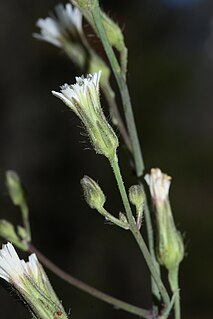
Pilosella albiflora is a common and widespread North American plant in the family Asteraceae, known by the names white hawkweed and white-flowered hawkweed.
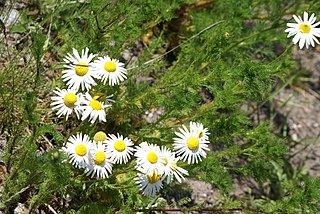
Tripleurospermum is a genus in the chamomile tribe within the sunflower family. Mayweed is a common name for plants in this genus.

Pilosella caespitosa is like several other Pilosella species and has a similar appearance to many of the hawkweeds.
Pilosella levieri is a species of flowering plant in the family Asteraceae.
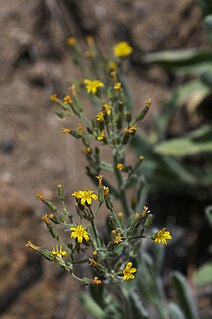
Pilosella horrida, known as the prickly hawkweed or shaggy hawkweed, gets its name from the long, dense, shaggy white to brown hairs (trichomes) which cover all of the plant parts of this plant species. The species is native to Oregon, California, and Nevada in the western United States.
Utricularia schultesii is a small, terrestrial, perennial carnivorous plant that belongs to the genus Utricularia. U. schultesii is endemic to South America, where it is only known from the type location in Colombia and additional collections in Venezuela. It was published and described by Alvaro Fernández-Pérez in 1964.
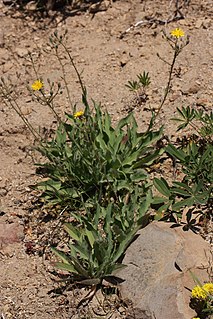
Pilosella scouleri is a North American species of flowering plant in the tribe Cichorieae within the family Asteraceae. It is known as Scouler's woollyweed. It is native to western North America, from British Columbia and Alberta in Canada, south to northern California and Utah in the United States.

Trypeta immaculata is a species of tephritid or fruit flies in the genus Trypeta of the family Tephritidae.

Oenothera pilosella is a species of flowering plant in the evening primrose family known by the common name meadow evening primrose. It is native to the United States and eastern Canada.
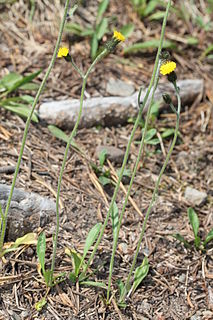
Pilosella tristis is a North American species of flowering plant known by the common name woolly hawkweed. It is widespread across western Canada and the western United States from Alaska, Yukon, and Northwest Territories south as far as California and New Mexico.
Pilosella abscissa is a plant species in the tribe Cichorieae within the family Asteraceae. It is considered to be native to the southwestern United States, Mexico and Central America.
Pilosella friesii – not to be confused with the European P. schultesii – is a North American plant species in the tribe Cichorieae within the family Asteraceae. It is widespread across much of Mexico with a few populations in Guatemala and western Texas.
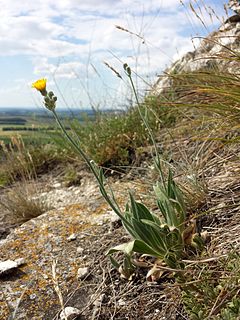
Pilosella echioides is a species of flowering plant belonging to the family Asteraceae.
Pilosella praealta is a species of flowering plant belonging to the family Asteraceae.











